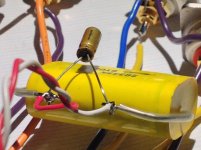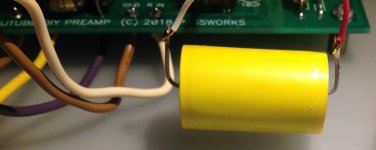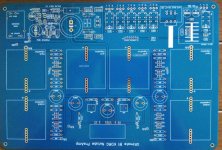ZenMod and Papa did some calculations in earlier threads. I think the general conclusion was 1 microfarad to 10 microfarad are OK, but less than that and the low frequency rolloff starts to impede too much.I have two 0.22μf caps and two 1μf. All of them are Mundorf MCap EVO Silver Gold Oil Capacitors. These are very sweet, when they are in the right place. Are these good for the Korg? There are bigger values in my boxes, like Solen , Mallory, Audyn, russian pios, etc. Not PPPs... I'll check tomorrow, I mean today... later.
1 microfarad with 0.22μf bypass would probably work fine. I used 2.2 μf polys and they worked great. I think the main problem might be the ergonomics of fitting them to the small board if they are the oversized types.
A little more dht luv. Latest version.
Hi! That's an interesting board.
Reservoir by Mundorfs and a superreg. Very simple and effective.
What is the circuit? can you give me some info?
Thanks.
Hello cjfrbw,
So I have averything that's necessary, no need to buy caps, unless it's very important that I use PPPs. Is it? Thanks.
So I have averything that's necessary, no need to buy caps, unless it's very important that I use PPPs. Is it? Thanks.
Hello, I have a question:
The Board must be fixed with conductive métal spacers or plastic to isolate it from the métal box ?
I use the diyaudio box
Gilles
The Board must be fixed with conductive métal spacers or plastic to isolate it from the métal box ?
I use the diyaudio box
Gilles
My board is fixed with metal spacers in an aluminium case. I can see that the holes in the board are connected to common ground, to a peripheral line, around the circuit.
Hi Polaron
If you read my posts you know already what min capacity is required in position 1 and 2, regardless of the power amp you use as that doesn't affect the calculation. You can go higher of course, but not lower than these calculated values, courtesy of ZM & Co BTW.
Regarding...
You are using very chep caps, very cheap compared to so many boutique's.
=> Define cheap? They are already quite expensive for what they are (merely caps LOL) and in terms of sound quality they definitely don't sound cheap. I am not sure buying more expensive caps will bring you better sonics in that DC blocking position, once you have quality PPPs, but different sonics perhaps (better or worst, you to decide). Well, there is an internet page where someone apparently compared many many "quality caps" and the ones I used do perform quite well, hence me trying them and confirming it. There are also other pages with boutique caps being measured and giving horrible results, probably due to their built process... or is that to give sonic flavours? ;-)
But anyway, if you have other brands and corresponding values already on hand, indeed just use them - especialy if you believe they sound better to your ears, no reason not to.
I have a classA power amp that happens to be an USSA-3 from Fab
=> Seems to be a nice amp. To calculate the correct 3rd cap, you need to know its input impedance. I happen to follow Fred's excellent works. I don't remember for USSA-3 but I believe it is likely to be the same input impedance as USSA-5, which I believe is 22k (as probably the rest of his line up?). If so (you can always ask Fred), any cap value equal or higher than 1.4uF is fine in your case for the 3rd cap.
Note though that going for 3uF is a safe bet for the future in case you should use one day a power amp with an input impedance as low as 10k... but indeed today it appears it is probably not your case.
I hope this helps
Claude
If you read my posts you know already what min capacity is required in position 1 and 2, regardless of the power amp you use as that doesn't affect the calculation. You can go higher of course, but not lower than these calculated values, courtesy of ZM & Co BTW.
Regarding...
You are using very chep caps, very cheap compared to so many boutique's.
=> Define cheap? They are already quite expensive for what they are (merely caps LOL) and in terms of sound quality they definitely don't sound cheap. I am not sure buying more expensive caps will bring you better sonics in that DC blocking position, once you have quality PPPs, but different sonics perhaps (better or worst, you to decide). Well, there is an internet page where someone apparently compared many many "quality caps" and the ones I used do perform quite well, hence me trying them and confirming it. There are also other pages with boutique caps being measured and giving horrible results, probably due to their built process... or is that to give sonic flavours? ;-)
But anyway, if you have other brands and corresponding values already on hand, indeed just use them - especialy if you believe they sound better to your ears, no reason not to.
I have a classA power amp that happens to be an USSA-3 from Fab
=> Seems to be a nice amp. To calculate the correct 3rd cap, you need to know its input impedance. I happen to follow Fred's excellent works. I don't remember for USSA-3 but I believe it is likely to be the same input impedance as USSA-5, which I believe is 22k (as probably the rest of his line up?). If so (you can always ask Fred), any cap value equal or higher than 1.4uF is fine in your case for the 3rd cap.
Note though that going for 3uF is a safe bet for the future in case you should use one day a power amp with an input impedance as low as 10k... but indeed today it appears it is probably not your case.
I hope this helps
Claude
Quote: So I have averything that's necessary, no need to buy caps, unless it's very important that I use PPPs. Is it? Thanks.
=> Err, Polaron, you do understand PPP is not a brand, don't you? This is a family of caps so to speak, based on their construction. Some you named (Solen, Mundorf...) are PPP caps...
Just don't use electrolytics, but PPPs, whatever your favourite brand...
Claude
=> Err, Polaron, you do understand PPP is not a brand, don't you? This is a family of caps so to speak, based on their construction. Some you named (Solen, Mundorf...) are PPP caps...
Just don't use electrolytics, but PPPs, whatever your favourite brand...
Claude
ZenMod and Papa did some calculations in earlier threads. I think the general conclusion was 1 microfarad to 10 microfarad are OK, but less than that and the low frequency rolloff starts to impede too much.
In fact the conclusion was (and is) that 0.22uF for the 1st cap and 1uF for the 2nd cap are OK (or anything higher of course) - indeed in order not to filter too much lower frequencies.
Claude
Hi Polaron
I have recently listened to a few different build methods of the Korg B1, which the experience was reported on this thread last weekend.
There is a what I can determine a natural curiosity to extract a Sound Quality (SQ), that is noticeably better than the Basic Build Korg B1.
I feel my auditions and listening experience was a demonstration of this curiosity.
I found the experience very informative, and was left impressed with the basic version, as well as the other versions, through to the advanced build type, that went further than the basic build, using Blackgates and a muting circuit addition.
ClaudeG has produced works and supplied information that has been a stimulus for such furthered build types as I experienced.
There is a keen interest to receive information on the alternative choices being made on a build, it is shame you don't seem to have a basic build model on standby to return to as a reference, as there will be noticeable changes, but whether they are improvements or just the sonic signature of boutique part will not be recognised.
As a example the experience I had, with Line up one and two, were showing the strengths of the B1 Korg and the traits that make it such an attractor.
The experience of the third in the line up, even though there was much more of a noticeable change in the presentation, and what could be referred to as impressive by some listeners, for me the traits that make the Korg B1 such a attractor were being masked, and as a result were for me becoming a noticeable detractor.
The fourth in the line up, has undergone a attention to boutique parts in a similar method as to the methods you are proposing.
This version has left a very good impression, and is for me to be aspired to.
As a guestimate, there would be approximately another $300 ?? to be spent between Line Up 1 and Line Up 4
There will be a interest in seeing the reports returned on your component exchanges.
I have recently listened to a few different build methods of the Korg B1, which the experience was reported on this thread last weekend.
There is a what I can determine a natural curiosity to extract a Sound Quality (SQ), that is noticeably better than the Basic Build Korg B1.
I feel my auditions and listening experience was a demonstration of this curiosity.
I found the experience very informative, and was left impressed with the basic version, as well as the other versions, through to the advanced build type, that went further than the basic build, using Blackgates and a muting circuit addition.
ClaudeG has produced works and supplied information that has been a stimulus for such furthered build types as I experienced.
There is a keen interest to receive information on the alternative choices being made on a build, it is shame you don't seem to have a basic build model on standby to return to as a reference, as there will be noticeable changes, but whether they are improvements or just the sonic signature of boutique part will not be recognised.
As a example the experience I had, with Line up one and two, were showing the strengths of the B1 Korg and the traits that make it such an attractor.
The experience of the third in the line up, even though there was much more of a noticeable change in the presentation, and what could be referred to as impressive by some listeners, for me the traits that make the Korg B1 such a attractor were being masked, and as a result were for me becoming a noticeable detractor.
The fourth in the line up, has undergone a attention to boutique parts in a similar method as to the methods you are proposing.
This version has left a very good impression, and is for me to be aspired to.
As a guestimate, there would be approximately another $300 ?? to be spent between Line Up 1 and Line Up 4
There will be a interest in seeing the reports returned on your component exchanges.
Well well well, I am getting a very nice support here from you dear members.. That's very kind of you, and this is all about the real original spirit of this forum and diy. Teach, learn, enjoy end share. Thanks a lot. Enough of this.
I choosed my caps. The choice is based on the caps I have and the experience I had with them, in some circuits where the sound differences are easy to discern.
- So cap one, for input, Sonicap 0,33μf in parallel with Mallory 22nf. Sonicaps are very good for me, transparent, but there is a certain "coldness". Be aware, they are musical. This coldness is a known characteristics about this series. It is often used with a litle "warmer" Sonicap in parallel from Gen2 series, more warmer; Mallorys do this trick very well. I like it. It will do no harm.
- Cap two, triode, Mundorf Silver Gold oil. This belongs to the white case series. It is for me very melodious, sweet, very rich, refined, nice tone and balance. No need of extra cap in parallel. It has a light sound, kind of ethereal.
- Cap three, output. Mallory 2,2μf in parallel with Sonicap, from the "cold" series. BTW, this is the Gen1 series. The Mallory is well balanced, simple. It doesn't make mistakes, it is not ambitious. Makes everything better but does not excell in any department except the nice balance. It is warm. Coupled with a 0,1 Sonicap Gen1, this couple sounds more "audiophile", in a good way, less boring with more details and musicality. I bet it will be well paired with cap two. Cap 3 is more down to earth, if you allow me a bit more of lyrism.
That's funny, when I talk about caps it's like I'm talking about persons. That's because I've experienced it and it creates an emotional link.
I will try to make this upgrade today. I have a birthday party, it will not be easy. I have to take the board out of the case, etc. Of course that I will report the results and will post some photos.
That's it!
I choosed my caps. The choice is based on the caps I have and the experience I had with them, in some circuits where the sound differences are easy to discern.
- So cap one, for input, Sonicap 0,33μf in parallel with Mallory 22nf. Sonicaps are very good for me, transparent, but there is a certain "coldness". Be aware, they are musical. This coldness is a known characteristics about this series. It is often used with a litle "warmer" Sonicap in parallel from Gen2 series, more warmer; Mallorys do this trick very well. I like it. It will do no harm.
- Cap two, triode, Mundorf Silver Gold oil. This belongs to the white case series. It is for me very melodious, sweet, very rich, refined, nice tone and balance. No need of extra cap in parallel. It has a light sound, kind of ethereal.
- Cap three, output. Mallory 2,2μf in parallel with Sonicap, from the "cold" series. BTW, this is the Gen1 series. The Mallory is well balanced, simple. It doesn't make mistakes, it is not ambitious. Makes everything better but does not excell in any department except the nice balance. It is warm. Coupled with a 0,1 Sonicap Gen1, this couple sounds more "audiophile", in a good way, less boring with more details and musicality. I bet it will be well paired with cap two. Cap 3 is more down to earth, if you allow me a bit more of lyrism.
That's funny, when I talk about caps it's like I'm talking about persons. That's because I've experienced it and it creates an emotional link.
I will try to make this upgrade today. I have a birthday party, it will not be easy. I have to take the board out of the case, etc. Of course that I will report the results and will post some photos.
That's it!
Last edited:
I would like to use a Mundorf Silver oil in the input, but I remanber now that I installed them in a power amp.
..I will try to make this upgrade today..
Keep electrochemical 10uF caps and bypass them ( solder in parallel )
with a small no polarised capacitors is another interesting option 🙂
Maybe solder two wires at (+) and (-) of cap soldering points for tweak time.
So You can enjoy experimentations is safe conditions.
With all this heat and mechanical changes is easy to damage pcb.
Best regards
Attachments
Ok, good idea, I can solder and desolder the legs of the lytics to those of the films, so the board will not be touched or damaged. My 10μf lytics are non-polarized. The holes in this board have very thin and litle pads. I will use good desoldering braid to avoid machanical stress on the holes. At worst, if a hole is damaged, I will solder the cap's leg to the next contact, following the trace, but I really don't like to do this, have to avoid it. The soldering tip is very thin and the station is good.
Last edited:
Those gonna be popular! I will take two 🙂
- Home
- Amplifiers
- Pass Labs
- B1 with Korg Triode



